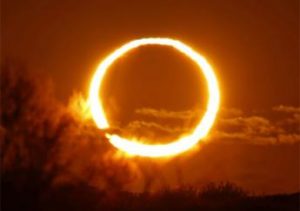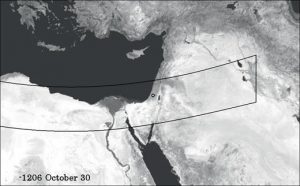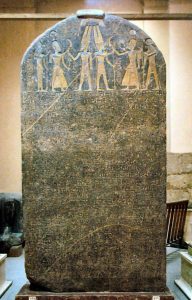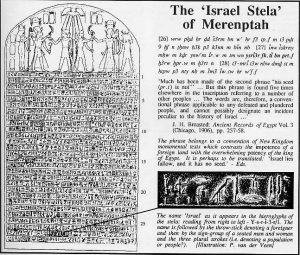Back in August I was lucky enough to have had an almost perfect view of the recent total Solar eclipse that crossed the USA, (See Post of 24August17) so went I came across an article entitled “Solar Eclipse of 1207BC helps to date the Pharaohs” I was instantly intrigued. It only took me a few minutes to find and download the original article at the journal ‘Astronomy and Geophysics’. What I read was certainly interesting but also clearly displayed some of the difficulties in trying to use modern science to study ancient, semi-legendary records of past events.
The article was written by Colin J. Humphreys of Selwyn College at Canbridge University and Graeme Waddington, an independent scholar. What Humphreys and Waddington propose is that the astronomical miracle described the Old Testament book of Joshua (Joshua 10:12-14) was not as usually translated the Sun and Moon standing still at Joshua’s command but rather a description of a Solar eclipse.
This idea is not actually new. As Humphreys and Waddington themselves point out the linguist Robert Wilson realized over a hundred years ago that the Hebrew words dôm and ‘amad could also mean that the Sun and Moon stopped shining, i.e. an eclipse. However, when astronomers did the calculations to find that ancient eclipse they discovered that there was none appearing in Canaan around the right time.
What Humphreys and Waddington realized was that the earlier calculations of ancient Solar Eclipses ignored the possibility of the event being an annular solar eclipse. Now an annular eclipse occurs when the Moon is at the farthest point in its orbit and therefore appears smaller in our sky, too small in fact to completely cover the Sun leaving a bright annular ring of sunlight. See picture below.

Doing the calculations Doctors Humphreys and Waddington found that there had been an annular eclipse across North Africa and Canaan on the 30th of October in the year 1207 BC. This eclipse they claim is the miraculous event depicted in Joshua, chapter 10. The image below shows the path of the annular eclipse.

Now to the ancient Hebrews an annular eclipse of the Sun would still be more than spooky enough to be remembered and connected to their legendary hero Joshua. At this point however the authors indulge in some hand waving, just suppose type arguments to provide a little more evidence. For example they claim that the reduction in sunlight during the afternoon, followed by the return of light after the eclipse’s maximum and then concluding with a real sunset could very easily be described as “The Sun did not hurry to set for about a whole day” (Joshua 10:13 New Revised Standard Version or NRSV).
To me this is part of the problem of trying to use modern science to describe biblical or mythological stories IN DETAIL! These stories have been so elaborated, so dramatized that any historical reality is deeply buried. You have to massage the surviving evidence to make it appropriate for the scientific explanation you’re suggesting.
In fact the very existence of the biblical hero Joshua and the Israelite “conquest” of Canaan has been seriously called into question. Professor Israel Finkelstein of the Department of Archeology at Tel Aviv University has published a series of papers and books detailing a broad spectrum of evidence that the Hebrew people developed in situ, that is the Hebrews were originally Canaanites who developed a different culture and came to consider themselves a different people, not an outside people who conquered the central highlands region of Canaan. According to Doctor Finkelstein, the stories of Exodus and Joshua are simply that, stories. There is no archeological evidence to support them. Trying to connect an astronomical event to such “history” may be completely impossible.
(If you’re interested in leaning about Doctor Finkelstein’s work I heartily recommend his “The Quest for Historical Israel” available at Amazon)
Still, up to this point I was with Doctors Humphreys and Waddington, but then they made a connection that just went to far for me. At the time of their eclipse, 30Oct1207BC, the Pharaoh in Egypt was named Merneptah, the son and successor of the famous Rameses the second. Now it happens that we know the number of years these men reigned better than the actual dates. The first year of Mernephat’s reign is considered to have been anywhere between 1213BC to 1204BC.
However, Merneptah is also know for having inscribed a stone slab with details of his victories (such a stone slab is known as a stele), including his victory over Israel! The images below show the entire stele along with the section mentioning Israel.


Based on this stele Humphreys and Waddington have concluded that Merneptah’s first year as Pharaoh was either 1210BC or 1209BC. As I first read their conclusion I didn’t see the connection to Joshua’s eclipse, Mernephat’s stele mentions Israel but says nothing about anything like an eclipse. Then I thought, are they assuming that Mernephat’s victory over Israel was also Joshua’s victory over the Amorites!!!
That’s way too much of an assumption for me! There is no evidence of any kind that Mernephat and Joshua fought each other or indeed existed at the same time, if Joshua existed at all. Assuming that the two stories of battles are about the same battle is just pure speculation.
I have decided to attempt to contact Doctors Humphreys and Waddington to ask for a little clarification, who knows maybe I missed something somewhere. I’ll let you know when and if I receive an answer.
If you’d like to read the original article ” Solar Eclipse of 1207BC helps to date Pharaohs” click on the link below.
UPDATE: I received a reply from Sir Colin Humphreys, one of the authors of the article. (I didn’t know he was a Sir! The Queen’s birthday honours list of 2010 according to Wikipedia.)
Anyway, Sir Colin accepts that the battles fought by Joshua and Merneptah were not the same but he does believe that the two campaigns were near enough in time to allow him to use Joshua’s Miracle (The Eclipse of 1207BCE) to more accurately date Merneptah’s reign as Pharaoh.
I can only say once again that I am reluctant to accept the bible that literally. Or Merneptah for that matter, remember his stele states that “Israel is laid waste, his seed is not”. Well that’s a boast that rings pretty hollow. And Merneptah’s stele is contemporary with his campaign while the book of Joshua is considered to have been written 500 years later!

This is the precise weblog for anybody who needs to seek out out about this topic. You notice so much its almost arduous to argue with you. You positively put a brand new spin on a subject that’s been written about for years. Nice stuff, simply nice!
Thanks for the comment. I hope you’ll keep coming back!
Bob L
Greetings! Very helpful advice within this article!
It’s the little changes which will make the most important changes.
Thanks a lot for sharing!
Thanks for the comment and come back soon!
Bob L